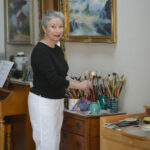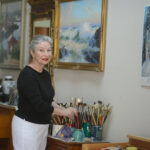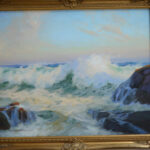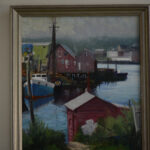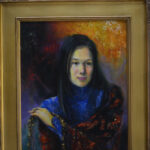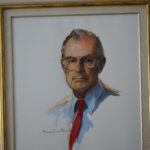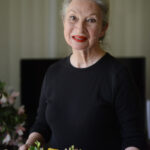
“I just love painting; I just love it! It doesn’t matter what medium I do,” says longtime Vero Beach resident Marlene Evans Putnam.
Well regarded for her work, particularly as a portraiture artist, she also teaches classes at the Vero Beach Museum of Art.
“And I just love teaching my students how much fun it is. It can make you so happy and, sometimes, frustrated at the same time.”
Putnam says she treasures the friendships she has made through her art and has also enjoyed learning about the history behind the lives of the people she has captured so beautifully on canvas.
Having been raised in Connecticut, Putnam jumped at the chance to return to the Northeast when the airline she was working for as a flight attendant offered her a base transfer from Pittsburgh to Boston, where she could nurture her artistic side.
“Boston was a dream. The first week I was there I went to the Boston Museum of Art school and signed up for all these art classes, up to five a week. I was determined I was going to be an artist, and I studied there for over seven years,” says Putnam.
“I loved the teachers, I loved the classes, for seven and a half years. I then studied semi-privately with several really top-notch artists from around the Boston area.”
Putnam also met her husband in an art class and after marrying they opened an art gallery on Rocky Neck, in East Gloucester, Mass., which they ran for 14 years.
“My husband was so supportive of me and felt I had such a talent,” she recalls with fondness.
Upon retirement, the couple moved to Vero Beach, which they had used initially as a ground base while searching the area.
“We didn’t know a thing about this place. We came upon it when spending time visiting towns along the Treasure Coast in 1980.”
After seeing a notice in the paper about a Vero Beach Art Club meeting, they decided to go.
“So we went, expecting to find maybe 10 people attending. But there were over 100 artists, and they just welcomed us with open arms and said, ‘We need good instructors here, and you’ll love it if you settle in Vero.’ We decided this was the place we liked best.”
She continued to paint most days and joined the Art Club, where she began teaching classes.
Putnam also became involved in the Alliance for the Arts, which was established in 1978 to create what is today’s Vero Beach Museum of Art. The Alliance raised $2.5 million from local, private sources, which enabled what was then called the Center for the Arts to open its doors to the public debt-free.
“Jean Armstrong, who started the museum, was such an incredible woman,” says Putnam.
“She was this tiny, very petite person, soft spoken, you would never dream in a million years that she could convince people to get behind this museum, but she did. She was simply amazing. She and her husband George Armstrong really went to work on this museum, got the idea across, got people behind it, they were wonderful! That museum is there because she did what she did. She had the courage to do it.”
Putnam and her husband continued to teach privately in Vero, but after her husband passed away in 2007, she was hired by the museum to teach classes there.
She considers her style to be somewhere between traditional and impressionistic, and likes to paint on scene, aka plein air, or by setting up her own still life scenes rather than using photographs, except occasionally for portraiture.
Her preferred portrait medium is oil, which she calls “such a sensuous medium. They stay wet, and you can go right back into them, and work and work on the painting.”
Many of her landscapes are based on scenes she has seen and studied, explaining that she can retain those images in her mind. “You can feel the wind, you can smell the salt air.”
Putnam is grateful that her art has been productive and well received. “That’s how I’ve made my living all these years. I have done very well with my artwork,” she says.
“When I was heavily into doing my portraits, it was very different, because the digital camera hadn’t been invented. That turned me into a dinosaur. Now, if someone wants a portrait, instead of paying $4,000 to get one, they can just take a picture, have it printed on canvas as a giclee, and it looks fantastic. It’s very hard to make a living as a portrait artist now, though I did well last year, selling a lot of paintings,” she says.
“I’ve met so many interesting, fascinating people here and have done so many portraits of notable people here,” she adds.
“The Opera Society here in Vero asked me to paint a portrait of the great Metropolitan Opera star Deborah Voigt,” says Putnam. “I did about a three-quarter, 40-inch by 60-inch portrait of her. She was just incredible. A very pretty woman. I just really loved painting her.”
After painting portraits of the late Richard Stark and his wife Barbara, ardent supporters of the arts and advocates of the homeless, she says they were so pleased with the results, they commissioned paintings of five of their grandchildren.
“Meeting these people and being around them has been a delight in my life. I thank God every day. I just can’t believe how absolutely fortunate I’ve been,” says Putnam. “I’ve met the most wonderful people in town. I just finished a portrait of Kathy Barton, whose husband Jeff was former Indian River County Clerk of Court.”
A portrait she painted of James Vocelle, one of Vero’s first attorneys in the 1920’s, is hanging in the County Courthouse.
“A remarkable man, so courageous. His son became a judge, and his grandson is a prominent attorney here. He used to live in Georgia, and ran for State Legislature, which he won, but never accepted, needing to move from Georgia due to threats on his life from the Ku Klux Klan,” remembers Putnam.
Another commissioned portrait was that of Rosemary Barkett; born in Mexico to Syrian parents, she was the first woman to serve on the Florida Supreme Court and the first female chief justice. The painting hangs alongside some 400 men in the Supreme Court Building in Tallahassee.
“I thought she was incredible, she was such a brave, brave woman. She had become a nun before becoming an attorney. She realized she had this gift and she wanted to do this. She became a judge, and then was elected to the Supreme Court. The men judges used to call her ‘Atilla the Nun’. She had such a good sense of humor. She is a federally appointed judge now.”
Having been a full-time artist for the past 40 years, Putnam says, “I have loved my career. If I died and was reincarnated, I’d come back as an oil painter again. I just love it that much.”
Photos by Alex Kowalski

